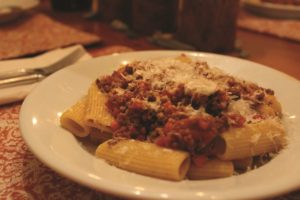Even though she went to culinary school and has a stack of cookbooks as high as our ceiling, my mother does not use recipes. So, for me, moving away from home came with a worry that none of the most important things in my mother’s repertoire — neither the latkes at Hannukah nor the lasagnas my brother and I endlessly demanded — would ever find their way into an organized notebook (or even a sticky note, for that matter) for me to follow.
But lessons from the childhood hours I spent sitting at the kitchen counter in Cambridge, watching the way a sauce thickens or meat browns in a cast-iron skillet, have stayed with me. Another one: you cannot learn how to dice an onion properly from words on a page; you first must chop off part of your pointer finger so you learn the dangers of holding a knife the wrong way.
Last year, I moved into a tiny apartment in Northampton with two friends. As the three of us tried to cobble together a new version of what senior year at college should look like, we started making family-style dinners. They held us together through the loneliness of social distancing and Zoom classes.
On a freezing cold January day something like the day I’m writing this in Wellfleet a year later — and with our vegetarian roommate out of town — I decided to make a Bolognese. I called my mom for some semblance of a recipe, and she recited an improvised ingredients list. If I needed further direction, she said, I should look to Marcella Hazan’s recipe in the New York Times. Her one other instruction was her answer to nearly all my culinary questioning: “Simmer it until it’s done.”
For most of my life that has seemed like an unhelpful piece of advice. But this time it started to make sense. Authentic Bolognese differs greatly from the American version of spaghetti topped with a generic meat and tomato sauce. Both tomato-rich sauces and spaghetti itself are from Naples, not Bologna. For Italian cooks, deeply rooted in their regions, this distinction is huge. The evolution of Bolognese — or its devolution, depending on which indignant Italian you ask — likely grew in early 20th-century America with an influx of Italian immigrants from the warmer, tomato-growing regions.
Bolognese is, in its true form, a ragu, a meat-based sauce cooked slowly for a long time. The dish begins with a classic soffrito: onions, celery, and carrots, diced and cooked in oil to soften and even slightly caramelize. Then you add the meat. Though this recipe includes beef and pork, historically veal or even pancetta have been used.
The original recipe, which first appeared in 1891 in Pellegrino Artusi’s cookbook La scienza in cucina e l’arte di mangier bene (translated by Murtha Baca for the Lorenzo Da Ponte Italian Library edition as Science in the Kitchen and the Art of Eating Well), included the notable instruction to add some milk or cream to thicken the sauce and make it smoother. The milk, added after the meat, tenderizes it and deepens the flavor of the sauce. The addition of wine has the same effect, though the wine can be red or white, or not included at all.
The final step in my version, adding the tomatoes, is one of the newer adaptations of the recipe. The earliest versions did not have tomatoes, only very slowly stewed meat. With that in mind, I let my sauce simmer on very low heat, watching it turn velvety as the hours went by. Gradually, my mother’s advice started to make sense — make sure you cook it until it’s done.
January Bolognese
Serves 4 to 6

2 Tbsp. olive oil
2 Tbsp. unsalted butter
1 small white onion, diced
1 medium carrot, diced
1 celery stalk, diced
1 lb. ground beef
½ lb. ground pork
A pinch of nutmeg
1 tsp. salt
Freshly ground black pepper
1 cup whole milk
1 cup dry red wine
1 28-oz. can whole peeled tomatoes
1 lb. pasta (rigatoni or tagliatelle)
Parmesan cheese
Heat olive oil and butter in a large, heavy-bottomed saucepan on medium heat and cook onion, carrot, and celery until soft but not brown. The onions should be translucent.
Add the meat, breaking it up with a fork, and cook until brown and crumbled. Add salt, nutmeg, and a few grindings of pepper.
Add milk and reduce to a simmer, stirring occasionally until fully reduced. Then add wine and continue to stir until reduced. Do not worry if this takes a long time; it’s supposed to.
Add tomatoes, breaking them up with a wooden spoon as they soften. Continue to simmer the sauce on very low heat for up to three hours, or until the liquid is reduced and the sauce has a velvety texture. You may need to add a half cup of water or so towards the end to keep the sauce from drying out. Taste the seasoning and add more salt if needed.
Cook the pasta. When it is al dente, reserve a half cup of the pasta water, then drain the pasta.
Top with Parmesan cheese just before serving.
A note on saucing your pasta: Traditionally, Americans sauce their pasta far more heavily than classic Italian dishes call for. To serve Bolognese in the most traditional way, drain your pasta while it is still al dente, after reserving a ½ cup of pasta water. Then, mix a small amount of sauce into the pasta, adding a bit of the pasta water as needed to keep the texture smooth and glossy, and let the sauce and pasta simmer together for another 30 seconds to one minute. Once plated, place a small portion of sauce on top of the already lightly sauced pasta.



